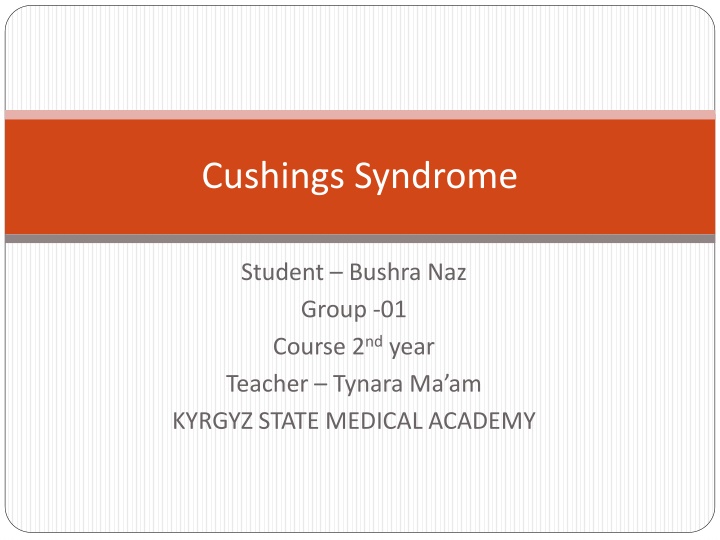
Overview of Cushing's Syndrome: Symptoms, Diagnosis, and Treatment
Explore a comprehensive overview of Cushing's syndrome, including the pituitary gland, key conditions, etiology, symptoms, diagnostic tests, and differential diagnosis. Gain insights into Cushing's disease versus syndrome, along with helpful revision tips. Delve into the complexities of this endocrine disorder and enhance your knowledge effectively.
Download Presentation

Please find below an Image/Link to download the presentation.
The content on the website is provided AS IS for your information and personal use only. It may not be sold, licensed, or shared on other websites without obtaining consent from the author. If you encounter any issues during the download, it is possible that the publisher has removed the file from their server.
You are allowed to download the files provided on this website for personal or commercial use, subject to the condition that they are used lawfully. All files are the property of their respective owners.
The content on the website is provided AS IS for your information and personal use only. It may not be sold, licensed, or shared on other websites without obtaining consent from the author.
E N D
Presentation Transcript
Cushings Syndrome Student Bushra Naz Group -01 Course 2ndyear Teacher Tynara Ma am KYRGYZ STATE MEDICAL ACADEMY
Objectives Brief overview of the pituitary gland Brief overview of all three conditions Review: aetiology presentation investigations complications prognosis Brief case presentations Revision tips
Pituitary gland Anterior and Posterior Anterior hormones (FLAT-GP): F FSH L LH A ACTH T TSH G GH P Prolactin Posterior hormones (OA) : O Oxytocin A ADH
Definitions Cushings Increased glucocorticoid exposure Addisons Chronic primary adrenocortical insufficiency Acromegaly Increased growth hormone production
Disease vs. Syndrome Cushings Disease is the result of a pituitary tumour secreting inappropriate ACTH Cushings Syndrome causes the same symptoms, but is caused by overproduction of adrenal hormones. It encompasses all other forms of Cushings Basically: Disease = increased cortisol from pituitary Syndrome = all other sources
Aetiology Harvey Cushing in 1932 Endogenous Causes: 65% = pituitary = Females 5:1 ratio and ages 25-40 25% = adrenals 10% = ectopic source (small cell lung ca), non-pituitary, ACTH producing tumour Exogenous Causes: Iatrogenic Steroids (Asthma, RA, palliative) Higher incidence in people with: DM, HTN, Obesity and Osteoporosis
S&S SWEDISH S Spinal tenderness W Weight gain E Easily bruise D Diabetes I Intercapsular fat pad S Striae H HTN
Differential Diagnosis Pseudo-Cushingoid: Chronic severe anxiety and/or depression Prolonged excess alcohol consumption Obesity Poorly controlled diabetes HIV infection
Investigations Bedside? Bloods tests which and why? FBC raised WCC U/E low K Special tests: Cortisol at midnight and 0900 (loss of diurnal variation should be low at midnight <550) less reliable 24 hour urinary cortisol 3 collections 24 hour salivary cortisol sampling Dexamethasone Suppression Test
Dexamethasone Suppression Test Overnight Low dose = Baseline reading, Dex 1mg given at 11pm, measure cortisol at 8am If cortisol low (<50nmol/L) = normal If cortisol high (>50nmol/L) = investigate further Cushings syndrome Localising the lesion: Plasma ACTH if undetectable = adrenal cause (as adrenal cause independent of ACTH) If detected proceed to high dose dex suppression test High dose if >90% suppression pituitary if less/no suppression ectopic source
Investigations If any positive - imaging: CT of adrenals MRI pituitary If ?ectopic: CXR CT =/- MRI of neck, thorax, abdomen
Management Always split in to: Conservative Medical Surgical
Management Drug therapy remains very important for normalising cortisol levels. Medical treatment can also be used in patients who are unwilling or unfit for surgery. Metyrapone, ketoconazole, and mitotane can all be used to lower cortisol by directly inhibiting synthesis and secretion in the adrenal gland. The treatment of choice in most patients is surgical but the metabolic consequences increase the risk of surgery: increased tissue fragility poor wound healing HTN and DM
Surgical Treatment Pituitary tumours: trans-sphenoidal microsurgery. Radiation therapy may be used as an adjunct for patients who are not cured. Bilateral adrenalectomy may be necessary to control toxic cortisol levels. Adrenocortical tumours: require surgical removal can develop Nelsons Syndrome Removal of neoplastic tissue is indicated for ectopic ACTH production. Metastatic spread makes a surgical cure unlikely or impossible. Bilateral adrenalectomy is indicated if necessary to control toxic cortisol levels.
Prognosis Patients with incompletely controlled Cushing's syndrome have a five-fold excess mortality. Premature death in untreated Cushing's syndrome are caused by vascular disease (MI/CVA), uncontrolled DM and infections. The usual course is chronic, with cyclical exacerbations and rare remissions. The prognosis is better with surgery. The rare adrenocortical carcinomas have a 5-year survival rate of 30% or less.
Reference Textbook of pathology Harshmohan pg no. 150,151 Cushing syndrome : A guide Wals Mary The hypothalamic Pituitary Disease book pg no.220 https://labtestsonline.org conditionsCushing Syndrome | Lab Tests Online https://www.webmd.com cushing-...Cushing Syndrome (Disease): Symptoms, Causes, Diagnosis ...





















